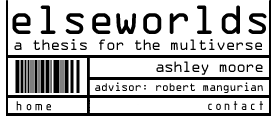

| statement | introduction | site | program | methodology | precedents | development | |
|
program(s) In the following section of the text, a set of terms have a relative set of definitions: 'BUILDING' is defined as any item or that the thesis suggests be added to, removed from, or moved about the site. 'PROGRAM' is defined as the events of commerce, education, entertainment, production, and other incarnations of human interaction and necessities which occur within the BUILDING. 'program' is defined as the survival skills of the BUILDING, following the notion that the building's first purpose and responsibility is to itself; considering it as though it were an sentient organism which must be adaptable and ingenious to ensure its continued existence.The PROGRAM of the BUILDING, in this case, is indeterminable at this time. As seen in section 'site', this notion of PROGRAM (ex. events such as television studios, infant hatcheries, or argonaut battlegrounds) will be resolved by one of two scenarios. In the first scenario, the PROGRAM - (ex. gestation theaters or car parks) will, minimally, be suggested by the inherent resources and adjacent requirements of the site; inversely, maximally, all PROGRAM will be determined exclusively - perhaps even refused - by the insurmountable obstructions on the site. In this case, the neighborhood should be searched for clues of what naturally exists or existed on the site, independent of commercial or formal desires. That which a community needs will sustain any building, be it either an empty vessel or a monument. In the second scenario, the PROGRAM (ex. sonic prototyping or kelp canneries) will be an absolute solution which is applied to all sites, regardless of their capacities. If the second case is the dominant, it is hopefully for just and rational reactions to the conditions with which I am confronted; caution must be kept in and effort to avoid brash indoctrination of the landscape. These terms are meant to warn of the outcome of forcing a piece of infrastructure into and environment to which is it not native. In either event, the PROGRAM of the BUILDING is inconsequential compared to a program of an architecture that is sustainable, durable, responsible, efficient, ecological, and recyclable. (In either event, the PROGRAM of the BUILDING is inconsequential compared to a program of an architecture which results in a BUILDING that is responsible, by which I mean PROGRAMMATICALLY sustainable, physically durable, energy and temporally efficient, ecologically responsive, and materially and occupationally recyclable.) Rather than address these issues solely with direct concerns of form or material or detail, I will take an approach that foregrounds the relationship of the PROGRAM to time. The potential life span of most BUILDINGS is longer than the initial PROGRAMMATIC concerns for which they are originally developed; so, where there is the desire for a perpetually relevant BUILDING, it is perhaps most prudent to carefully keep from consideration, for as much of the planning as possible, all characteristics or idiosyncrasies of the PROGRAM that would lead to specific formal traits of the BUILDING. In some extreme cases, to ensure that the demands of a PROGRAM do not overwhelm completely any future possibility of a reoccupation, it may become necessary to enforce the complete denial of an intended Program. Rather than adaptation of one PROGRAM (ex. cotton mill) to another PROGRAM (ex. rental housing) which usually carries a 'response' of either denial or fetishization of the traits left by the previous PROGRAM, the most efficient move would be a preemptive architecture which would, at worst, provide for a frictionless transplantation of one to the next, or, at best, provide the ideal setting for the PROGRAM for as long as the architecture is materially sustainable. However, as the success of the program is ultimately dependent on the --economy, which is, in turn, dependent on the environment and demographics, the greatest care must then be taken to ensure that the BUILDING is perpetually sustainable in both its efficiency and its fashionability. In an optimized situation, the environments will be inhabitable on both ends of the time scale; long term adaptability of PROGRAMS which become outdated and short term conditions that change for hourly reoccupation. The conflict, at least the aspect of it which would be of interest to architects, which arises is one between the 'generic' and the 'specific', two terms that may be instinctively and carelessly equated to notions of banality and sublimity, careless and thoughtful, or blandness and intensity, each respectively. I argue that the intent of providing ultimately versatile space must not arrive at an ultimately faceless structure. Indeed, a crucial point to retain in the effort to provide the BUILDING with its durability is the by winning the hearts and minds of the user, through both formality or functionality. Either the BUILDING is so compelling that it is cherished and preserved, or it performs so well that it is retooled and conserved. The mediation for which I am searching is, that which will drive the BUILDING's maintenance the absence of Program. return to top  thesis content written by and property ashley moore, 2000-2015 thesis content written by and property ashley moore, 2000-2015valid: xhtml css |
|||||||